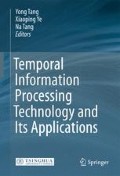Abstract
There are various kinds of temporal application modes in current information systems. In this chapter, we divide the temporal application modes into three kinds—the pure temporal mode, embedding temporal mode and mixed temporal mode. The temporal information view that links the temporal data and temporal knowledge is proposed. The temporal technologies in cooperative software are discussed, such as temporal role management and temporal workflow. Finally, the cases showing the comprehensive utilization of temporal technologies are described.
Access this chapter
Tax calculation will be finalised at checkout
Purchases are for personal use only
Preview
Unable to display preview. Download preview PDF.
References
Liu Dongning, Tang Yong, Tang Na, Wei Wei, Deng Zhi (2002) An inference model of temporal logic in an intelligent decision support system of salary. In: Proceedings of the 7th International Conference on Computer Supported Cooperative Work in Design, pp 351–354
Pan Y, Tang Y, Ma H and Tang N (2006) Workflow analysis based on fuzzy temporal workflow nets. Computer Supported Cooperative Work in Design II, LNCS 3865, pp 545–553
Snodgrass RT (2007) Towards a science of temporal databases. In: Proceedings of the 14th International Symposium on Temporal Representation and Reasoning, pp 4–5
Tang N, Tang Y (2008) Mapping bitemporal XML data model to XML document. Lecture Notes in Computer Science 5236, Springer, pp 342–352
Tang Y, Ji GF, Zhu J (2007) Cooperative software technology and its applications. China Machine Press, pp 3–10
Tang Yong, Li Song (2000) Knowledge representation of an intelligent decision support system of salary. In: Proceedings of the Seventh International Conference on IE&EM, pp 519–523
Tang Yong, Tang Na (2000) The design and implementation of intelligent decision support system of salary. In: Proceedings of the 7th International Conference on IE&EM, pp 385–389
Tansel AU, Imberman SP (2007) Discovery of association rules in temporal databases. In: Proceedings of the 4th International Conference on Information Technology New Generations, pp 371–376
Yu Y, Tang Y, Tang N, Ye XP (2004) A meta-model of temporal workflow and its formalization. In: Grid and Cooperative Computing, LNCS 3251, 987–992
Author information
Authors and Affiliations
Editor information
Editors and Affiliations
Rights and permissions
Copyright information
© 2010 Tsinghua University Press, Beijing and Springer-Verlag Berlin Heidelberg
About this chapter
Cite this chapter
Li, J., Tang, Y., Tang, N., Lai, H. (2010). Temporal Application Modes and Case Study. In: Tang, Y., Ye, X., Tang, N. (eds) Temporal Information Processing Technology and Its Application. Springer, Berlin, Heidelberg. https://doi.org/10.1007/978-3-642-14959-7_17
Download citation
DOI: https://doi.org/10.1007/978-3-642-14959-7_17
Publisher Name: Springer, Berlin, Heidelberg
Print ISBN: 978-3-642-14958-0
Online ISBN: 978-3-642-14959-7
eBook Packages: Computer ScienceComputer Science (R0)

